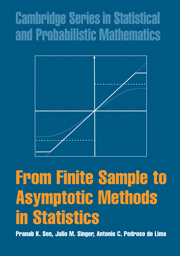Book contents
- Frontmatter
- Contents
- Preface
- 1 Motivation and Basic Tools
- 2 Estimation Theory
- 3 Hypothesis Testing
- 4 Elements of Statistical Decision Theory
- 5 Stochastic Processes: An Overview
- 6 Stochastic Convergence and Probability Inequalities
- 7 Asymptotic Distributions
- 8 Asymptotic Behavior of Estimators and Tests
- 9 Categorical Data Models
- 10 Regression Models
- 11 Weak Convergence and Gaussian Processes
- Bibliography
- Index
3 - Hypothesis Testing
Published online by Cambridge University Press: 05 June 2012
- Frontmatter
- Contents
- Preface
- 1 Motivation and Basic Tools
- 2 Estimation Theory
- 3 Hypothesis Testing
- 4 Elements of Statistical Decision Theory
- 5 Stochastic Processes: An Overview
- 6 Stochastic Convergence and Probability Inequalities
- 7 Asymptotic Distributions
- 8 Asymptotic Behavior of Estimators and Tests
- 9 Categorical Data Models
- 10 Regression Models
- 11 Weak Convergence and Gaussian Processes
- Bibliography
- Index
Summary
Introduction
Testing statistical hypotheses, a dual problem to estimation, has the prime objective of making decisions about some population characteristic(s) with information obtained from sample data. A statistical hypothesis is a statement regarding a target distribution or some parameters associated with it, the tenacity of which is to be ascertained via statistical reasoning. In this context, the decision based on random samples may not always be correct, so appropriate strategies are needed to control the frequency of such errors. In this respect, the genesis of finite-sample principles of hypotheses testing stemmed primarily from the pioneering work of J. Neyman and E. S. Pearson in the 1930s. The Neyman–Pearsonian foundation for parametric as well as nonparametric setups in conjunction with other tributaries are appraised here under a finite-sample (exact) methodological framework, along with its transit to asymptotic reasoning.
Section 3.2 deals primarily with the basic concepts and the formulation of simple hypotheses testing problems. The more likely situation of composite hypotheses testing is considered with more detail in Section 3.3. There, diverse statistical approaches yielding different testing procedures are considered. In particular, invariant tests are highlighted. The interplay of invariance and sufficiency in parametric as well as nonparametric setups is analyzed in Section 3.4. Bayes procedures are to be discussed in Chapter 4.
- Type
- Chapter
- Information
- From Finite Sample to Asymptotic Methods in Statistics , pp. 68 - 82Publisher: Cambridge University PressPrint publication year: 2009

